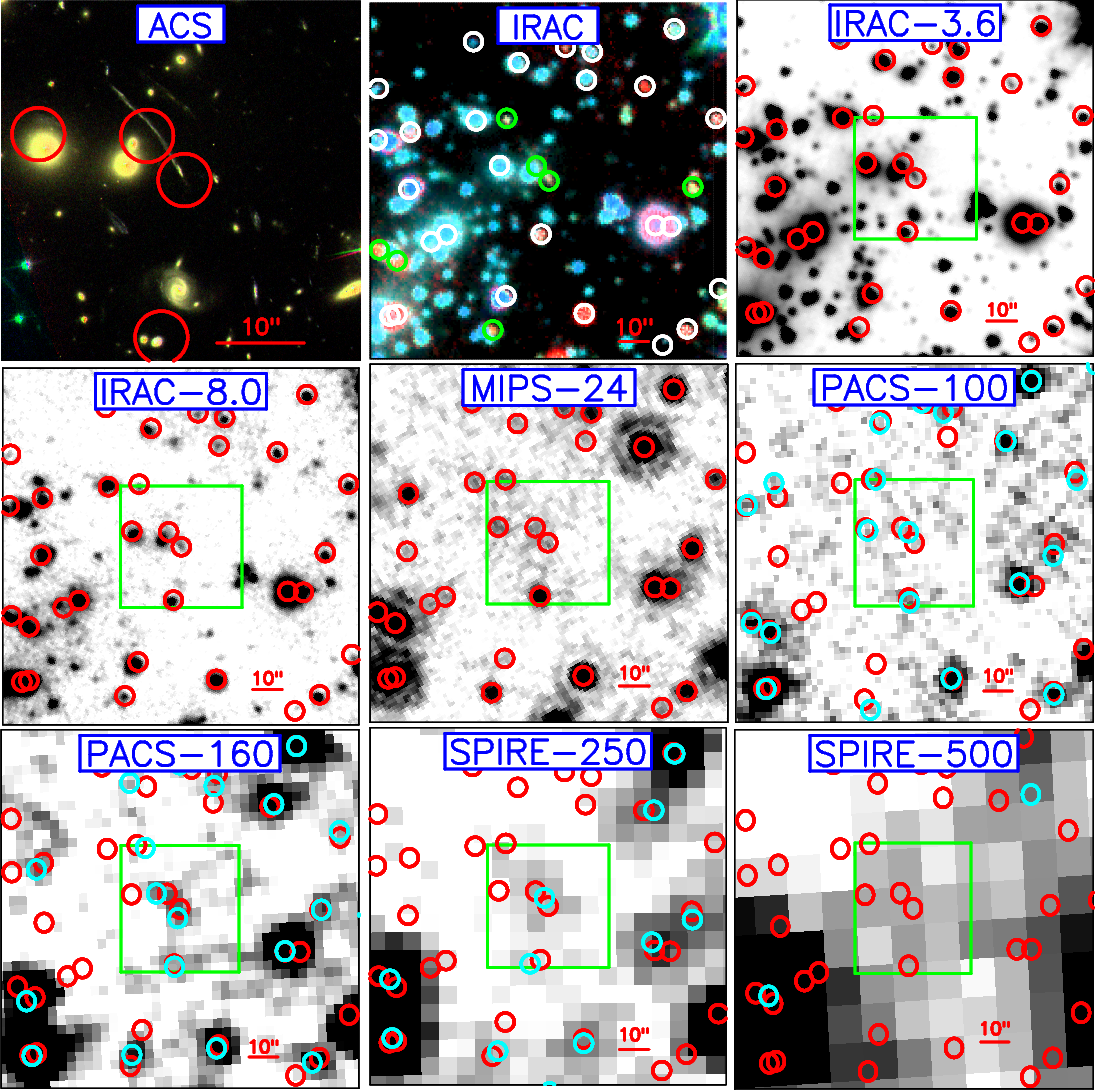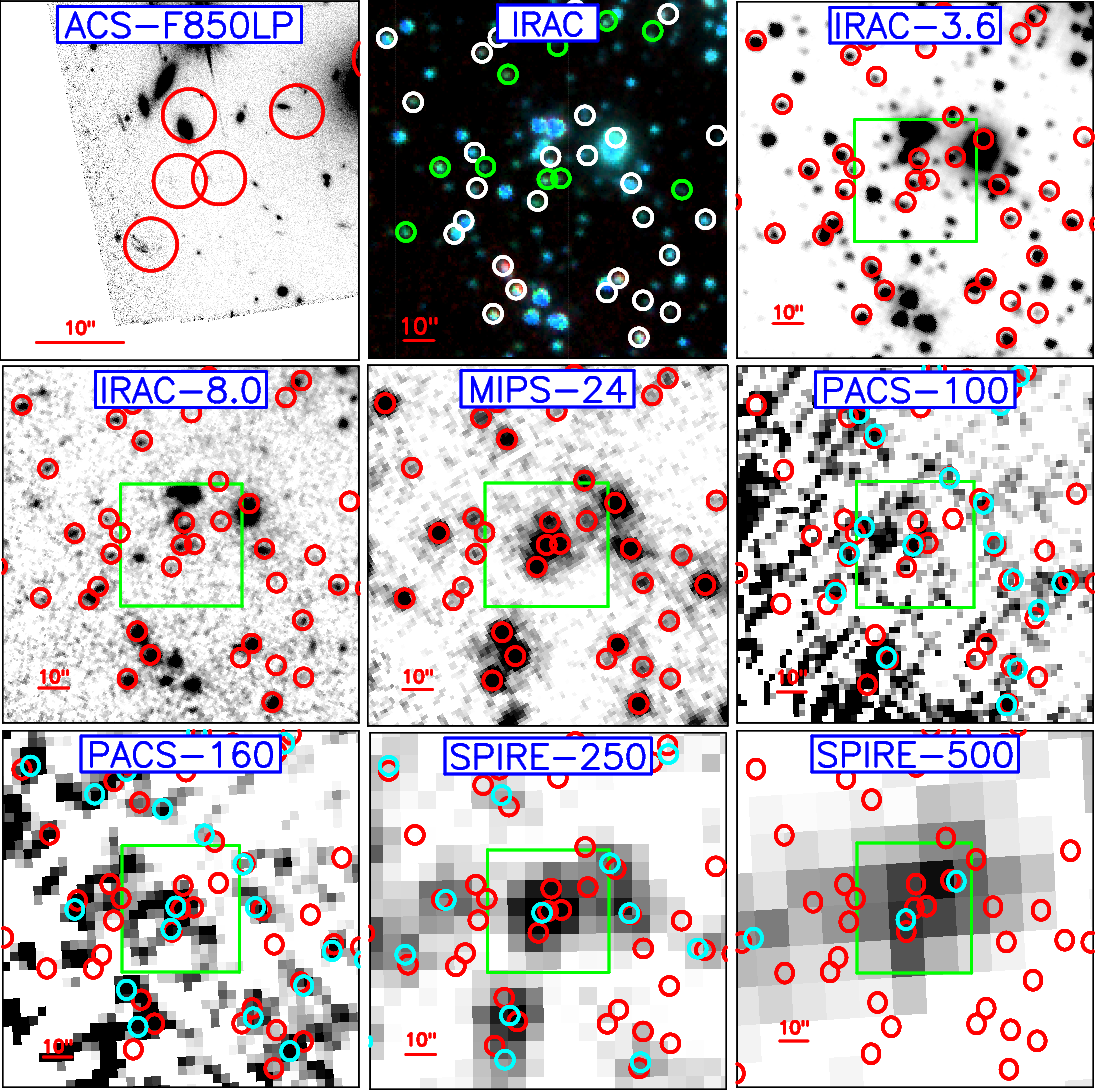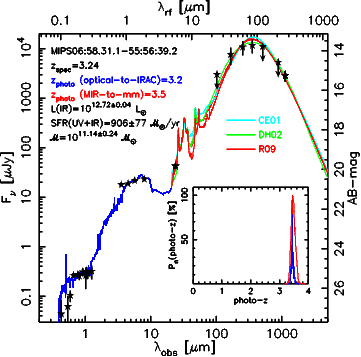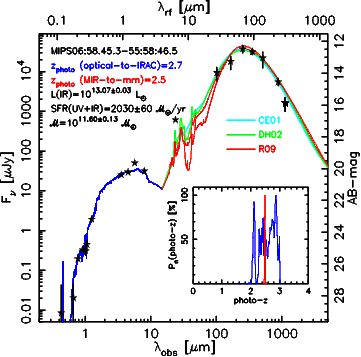

In the paper
Improving the
identification of high-z Herschel sources with position
priors and optical/NIR and FIR/mm photometric redshifts
(A&A 2010, 518, L15), we analyzed the
Herschel
data obtained with both the
PACS
and
SPIRE
instruments for the Bullet cluster. Our main goal was to
study the star formation in distant galaxies, benefiting
from the gravitational lensing created by the cluster to
detect and analyze faint sources at high redshift.
In this Letter, included in an
Astronomy
& Astrophysics Special Issue dedicated to the
Herschel
Space Telescope, we presented a preliminary analysis of
the Science Demonstration Phase (SDP) data taken for the
Herschel Lensing Survey Project, and Open Time Key Programme
led by
Eiichi Egami from the
University of
Arizona and awarded with nearly 300 hours of
Herschel
observing time.
The Letter presented the detection by PACS and SPIRE of 2
very interesting sources in the Bullet cluster field: the
lensed arc at redshift z=3.24 presented in
Mehlert
et al. (2001) and the sub-mm galaxy detected by LABOCA
and cataloged as source #10 in
Johansson
et al. (2010). Postage stamps in different photometric
bands are shown in the images above. On the left, we show
that both the
Spitzer Space
Telescope and
Herschel
were able to detect the IR dust emission from the Southern
tip of the arc with the MIPS (at 24 μm), PACS (at 160
μm), and SPIRE (at 250 and 350 μm) instruments. The
sub-mm galaxy was also detected in several bands from 24
μm to 500 μm, even though the source is very faint in
the optical (cf. HST ACS-F850LP image on the right image
above).
The work presented in the
Astronomy
& Astrophysics Herschel Special Issue consisted on using
the
Spitzer MIPS 24
μm imaging to recover robust fluxes and deblend faint
Herschel
sources near the confusion noise, i.e., using the positions
given in the MIPS 24 μm catalog as priors to dig into the
noise of the PACS and SPIRE data and measure FIR fluxes for
those sources. We discussed the advantages of this method,
and the general properties of the
Herschel
data: detection levels, source densities, fraction of
blended sources, etc... The Letter also illustrated the
power of using independent estimates of the photometric
redshift based on UV-to-NIR data and IR data alone to
validate the individual values (see the photo-z probability
distributions in the figures below). The procedure is also
useful for achieving more reliable identifications of the IR
emitters. For example, for the LABOCA source at z~2.6 (right
image above), we calculated photometric redshifts based on
UV-to-NIR data for the three close neighbors detected by
MIPS within 10" of the central source. The galaxy to the
North lies at z~0.3 (a cluster member), that to the south at
z~1.9, and the closest companion has a photo-z compatible
with the central source (z=2.3±0.3), thus implying that the
two sources are a possible interacting pair.


Once we had reliable source catalogs for the
Herschel
images, we discussed the properties of two interesting
galaxies in the field. We were able to estimate with high
reliability the total IR luminosity of the arc
MIPS06:58:31.1−55:56:39.2, which turned to be a LIRG at
z=3.24 (once you take into account the magnification of this
source). This estimation is very precise, since it is based
on up to 7 photometric data points in the MIR, FIR, and
(sub-)mm spectral ranges (using also
LABOCA
and
AzTEC data)
covering the peak of the Spectral Energy Distribution (SED),
which dominates the integrated IR luminosity. This
demonstrates that the use of the gravitational lensing
effect allows to detect faint IR sources at high redshift
which will not be recovered by the typical
Herschel
Cosmological Surveys (see, e.g.,
Elbaz
et al. 2010). We also showed that for this source the
TIR luminosity obtained with 24 μm alone was a good
estimation compared to the value obtained with the FIR and
(sub-) data using the
Rieke
et al. (2009) dust emission templates. In contrast,
several papers have shown problems in the estimation of
L(TIR) when only using MIPS24 for ULIRGs at high redshift,
indicating an evolution on the typical SED (and thus, the
dust and/or star formation properties) of this type of
galaxies (see, e.g.,
Papovich
et al. 2007,
Rigby
et al. 2008,
Rex
et al. 2010,
Elbaz
et al. 2010, Barro et al. 2010), but probably not for
LIRGs.
This SED evolution is also clear in the SED of the LABOCA
source MIPS06:58:45.3−55:58:46.5 presented in the Letter
Pérez-González
et al. (2010), a HyLIRG (assuming no magnification by
the cluster) at z~2.6 (average value from independent
estimations of the photometric redshift obtained from
UV-to-NIR data and MIR-to-mm data) for which there is no
template that can reproduce the MIPS24 emission jointly with
the FIR and (sub-)mm fluxes. Clearly, there is a higher
emission at rest-frame wavelengths around 6-7 μm than
that predicted by any template fitting the FIR-to-mm
range. This could be solved with a more prominent PAH
emission, or with an underlying MIR continuum emitted by
relatively large amounts of warm/hot dust (e.g., heated by
an obscured AGN).
Previous papers in this webpage
Exploring
the evolutionary paths of the most massive galaxies since
z~2 (Jun 2009)
The Stellar Mass Assembly of Galaxies from z = 0 to z = 4:
Analysis of a Sample Selected in the Rest-Frame
Near-Infrared with Spitzer (Jan 2009)
Created on Fri Jul 16 10:00:00 CEST 2010
Back to top







